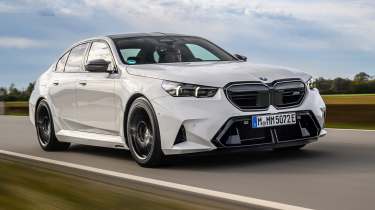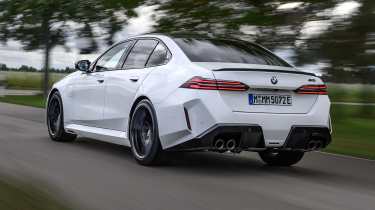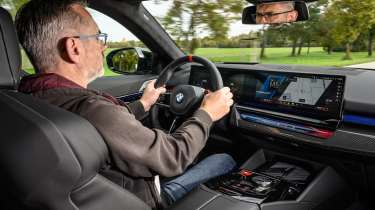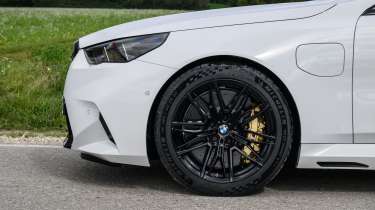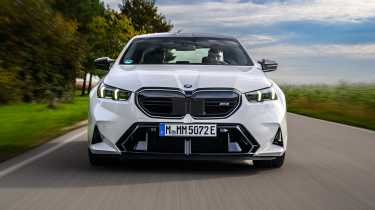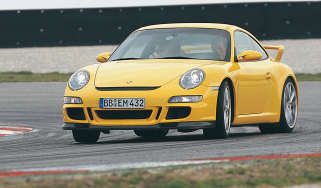BMW M5 saloon 2024 review – more power, more weight, same old M5 desirability?
So much has been written about BMW’s new plug-in hybrid M5, but now it’s time for the talk to stop and drive it
Does the new M5 - all 5.1m and 2500kg of it - manage to shrink around you and disguise its weight? Incredibly, the answer is yes, yes it does. Some excellent tuning and specific technologies help deliver this confounding result and we’ll explore them in due course but it’s not game, set and match yet, of course; even with this unlikely result in the bag, another crucial question still hangs in the air: is the new M5 a truly desirable M5?
Since the reveal of the new M5’s size and weight statistics it’s had a bit of a rough ride on forums. Frank Van Meel, BMW M GmbH’s boss, has been left somewhat exasperated, responding to the dragging with the statement: ‘But you haven’t driven it yet!’. He predicted this backlash when he drove the prototype at the Salzburgring in May, having previously taken flack for proposing to make the M5 four-wheel drive. Mind, this isn’t the small matter of adding a couple of drive shafts, it’s the most radical shift in the model’s 40-year history.
> BMW M5 CS Fast Fleet test – 9000 miles in the eCoty-winning supersaloon
Engineering it to be a plug-in hybrid sees it shipping a load of batteries and an electric motor that increase its kerb weight by over 500kg. Power has gone up too, the 4.4-litre, bi-turbo V8’s 577bhp boosted by up to 194bhp of electric assistance for a maximum combined output of 727bhp. That’s a huge figure but not enough to improve the power-to-weight ratio over the previous M5, which made 325bhp/ton (343bhp/ton in the sublime M5 CS) while the new car makes 290bhp/ton.
More reviews
In-depth reviews
Reviews
Don’t go thinking the new car is any way sluggish, though; plant the throttle and it snaps forwards immediately, the instant torque of the electric motor overcoming the car’s inertia in a blink before the V8’s turbos spool up and it joins the charge. BMW claims 0-62 in 3.5sec and 0-125 in 10.9. Initially, you can’t comprehend how suddenly the M5 responds to a snap-opened throttle, how its mass and inertia are cast aside. You need to recalibrate for how much pace you can pick up between corners, what overtakes are possible.
The seventh generation M5 is a big car - and the first M5 to have flared rear arches to go with flared fronts - and it looks big, whatever the colour, and there are some striking options. Inside, the seats have a more generous, less defined cut than those of the M3 and M4 (and M5 CS), though you can adjust the side bolsters for a torso hug. Essentially there’s a less overtly sporty feel to the cabin, though you can order silver, orange or luminous red trim.
Press the start button and there’s a synthesised start-up noise, like a portentous version of the Windows XP start-up jingle. With the drivetrain in EV mode you get a blue-themed version of the angular instruments, the speedo on the left peaking at 150kph (max speed in EV mode is 140kph, or 87mph), the right-hand scale showing the percentage of electric power being used. It goes up through the gears of the eight-speed ZF auto because the electric motor is fitted between the engine and gearbox, and there’s a synthetic, low-level ‘engine’ noise too, fed in through the speakers, though you can dive into the menus and turn it off if you wish. It’s good for an electric only range of up to 69km and feels brisk enough for the cut and thrust of the urban environment.
However, while it does indeed feel big – narrow lanes in roadworks are a test of nerve – you soon discover that the steering is remarkably good. The first time you steer into a decent turn you unconsciously build in a bit of a margin, assuming, based on your knowledge of its mass and its size, that it will take a moment to respond. Only it doesn’t. It steers cleanly and quickly, changing tack with an alacrity that defies expectation and, it seems, physics too.
I shouldn’t be surprised. When I drove the prototype M5 at the Salzburgring back in May, chasing down an M4 CS shod with Cup 2 Rs, it felt remarkably agile, in part due to BMW M’s first deployment of active rear-steering. This counter-steers the rear wheels for agility at low speed and parallel steers them at higher speeds for stability. It was almost too eager; arriving hard on the brakes and tipping it into the tight chicane, the car rotated so keenly that I hit a lot of the inside kerb… and then a lot of the next one too when I turned for the second part. It’s also generously tyred, with 285/40 ZR20s on the front and barely smaller than the 295/35 ZR21s at the rear, with our test car fitted with Michelin’s PS 5S tyre.
On the road in a straight line, waggle the wheel and you can feel that brightness of response but drive normally with measured inputs and the M5 tacks cleanly and precisely into turns. It feels like M engineers have given the car all the agility it should ever need but for everyday road driving has created a zone of calm around the steering’s centre, a place where you can work in a relaxed way. It feels wieldy with well-judged efforts, lovely linearity and a decent sense of what the front is doing, which is mostly going exactly where it’s pointed. There’s no understeer until you go hunting for it, getting on the throttle sooner and sooner in tight corners until finally the front Michelins squeal a little wide.
The steering is one of three key things that make this a much easier M5 to drive briskly than you might expect, the other two being superbly judged braking and excellent damping. The brake pedal gives reassuring response from the top of its travel without over-delivering, so the car never feels like it’s running away from you, and when you press harder it has superb feel in its mid travel so you can easily modulate the pressure to get the exactly level of retardation you want. This was with the optional carbon-ceramic brakes costing £8850, which seems like a good investment.
The damping plays its part too. All is calm on typically neat and smooth German roads, though an abrupt lateral ridge or sunken pothole breaks through the veneer of softness with a steely firmness that offers an insight into how much control there is keeping the mass in check. Find some properly gnarly asphalt and there’s a bit of jiggle but the suspension manages to round off the lumps and bumps.
The good thing is that in its base settings, with everything in ‘Comfort’, the car’s dynamic composure feels unshakeable. There are many modes, of course, many tuneable features so you can adjust the car to your taste, ramp things up, though on the road I’m not sure there’s any need for tighter damping. Shifting steering up to Sport increases the efforts but I felt it was less linear, while the Sport setting for brake feel was more useful, giving a stronger top-of-the-pedal response. Set the powertrain to Sport or Sport Plus and you get everything the V8 and electric motor can give, all the time, and the kick in the back is noticeably more savage.
Just how well judged the base settings are is revealed when you switch the drivetrain to the more dynamic MDM. This sends more drive to the rear and on other 4wd M models is the setting of choice for setting lap times, giving an adjustable but effective dynamic balance. On the road in the M5, you can feel the shift, the rear squirming as you accelerate hard out of turns, while in the wet it’s all a bit snappy. Two-wheel drive? A challenge, for sure.
As ever, you can go ‘a la carte’ and select a profile for the M1 and M2 but there’s also an M Drive button on the centre console and a new ‘boost’ feature: pull back and hold the left-hand paddle for a few seconds and you get a short-cut to maximum standing start performance, the head-up display announcing BOOST in capital letters, just so you know, with a count down before the feature drops out. Nail the throttle and the head of everyone in the car will thump into the headrest as the car rips for the horizon. Max speed is 155mph unless you upgrade to the M Driver pack which lifts it to 190mph, and the way it lunges to 150mph suggests that 190mph isn’t the possible top speed, just a raised limiter.
So, what about desirability? I’m disappointed that although it has a traditional offset crank V8, the latest M5 sounds remarkably like a flat-plane crank V8, despite the effect of piped-in character via the sound system.
Then there’s the bandwidth of the seventh generation M5. With EV mode and a rounded low-speed ride, the new M5 is relaxing in town. However, in some ways the extension in the other direction, beyond comfort, is illusory. For me, the new M5 is at its best as a road car in mostly comfort settings, offering control and precision and pace that defies its mass. It doesn’t need tighter damping or sharper steering. On track with everything cranked up, its agility and composure were impressive but I can’t ever imagine wanting to track such a huge car. It’s a remarkable car, the new M5, almost able to defy physics, but I admire it more than desire it.
Price and rivals
At £111,405, the saloon is no more expensive than the previous M5 Competition, which seems like good value given how much more tech is crammed in. Oddly, the new M5 doesn't have an awful lot of competition just yet, with Audi and Mercedes-AMG yet to unveil their new generation hybridised alternatives. The V8-powered Mercedes-AMG E63 is now off sale, with only the £90,860, 577bhp E53 hybrid available. The Audi RS7 is one of the only direct rivals to the M5, still available in V8-form for £116,200.
BMW M5 (2025, G90) specs
| Engine | V8, 4395cc, twin-turbo, plus 145kW e-motor |
| Power | 717bhp |
| Torque | 737lb ft |
| Weight | 2435kg (299bhp/ton) |
| Tyres as tested | Michelin Pilot Sport S 5 |
| 0-62mph | 3.5sec |
| Top speed | 155mph (189mph optional) |
| Basic price | £111,405 |

